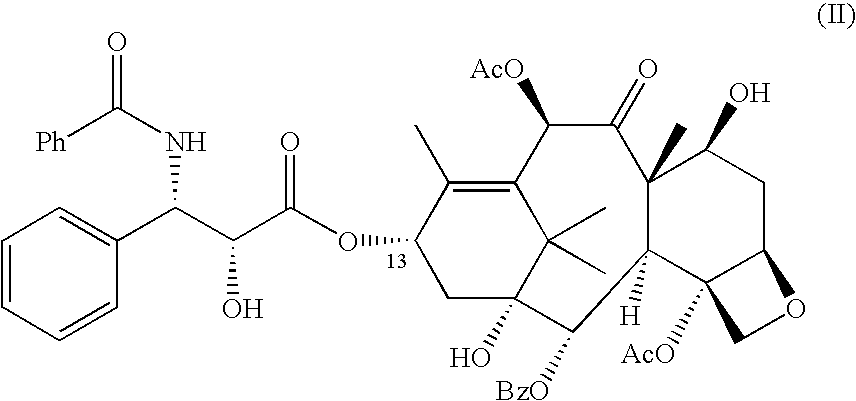Process for the preparation of (2r,3s)-3-phenylisoserine methyl ester acetate salt
a technology of methyl ester and acetate salt, which is applied in the preparation of aminocarboxyl compounds, chemistry apparatus and processes, and organic chemistry, etc., can solve the problems of troublesome scaling up of the process, long and expensive total synthesis of paclitaxel and docetaxel, and inapplicability to industrial scal
- Summary
- Abstract
- Description
- Claims
- Application Information
AI Technical Summary
Problems solved by technology
Method used
Image
Examples
preparation 1
Racemic 3-Bromo-2-hydroxy-3-phenyl-propionic acid methyl ester (Reference Example)
[0030]A mixture of benzaldehyde (212.0 g, 2.0 moles) and methyl chloroacetate (282.0 g, 2.6 mole) in methanol (320.0 g) was cooled to 0° C. under nitrogen. Sodium methoxide (466.0 g of a 30 wt % solution in methanol, 2.5 moles) was added over a period of 2 hours and the mixture was stirred for further 60 minutes at 0° C. The mixture was then allowed to reach 22° C. and stirred for further 2 hours at this temperature. After slow addition of acetic acid (30.0 g, 0.5 moles), toluene (465.0 g) and water (670.0 g) were added consecutively. The aqueous phase was separated and the organic layer was distilled in order to remove water and methanol. After removal of 170.0 g of distillate the mixture was allowed to cool to 25° C. HBr (120.0 g, 1.5 moles) was added over a period of 4 hours keeping the temperature at 25° C. After completion of the addition a mixture of 15.0 g of sodium bicarbonate in 300.0 g water ...
preparation 2
Racemic cis-3-phenylglicidic methyl ester (Reference Example)
[0032]Racemic 3-bromo-2-hydroxy-3-phenyl-propionic acid methyl ester (VII) (259.1 g, 1.0 mole) was suspended in water (700.0 g) and the mixture was heated up to 50° C. A solution of sodium carbonate (112.4 g) in water (660.0 g) was slowly added over a period of 1 hour. The mixture was stirred for further 60 minutes and toluene (365.0 g) was added allowing the mixture to cool down to room temperature. The aqueous layer was separated and the organic residue was washed with water (180.0 g). The organic layer was separated and concentrated in vacuo yielding the product as an oil. Yield: 157.4 g (0.88 mole, 88%).
[0033]1H NMR CDCl3 (δ): 3.58 (3H), 3.83 (1H), 4.290 (1H), 5.01 (3H), 7.39 (5H).
preparation 3
Racemic threo 3-phenylisoserine amide (Reference Example)
[0034]Racemic cis-3-phenylglicidic methyl ester (VIII) (430.0 g, 2.41 moles) was dissolved in methanol (2000.0 g) then 400.0 g of gaseous ammonia (23.5 moles) was added slowly keeping the temperature at 25° C. and the mixture was heated up to 60° C. and stirred for further 18 hours. The resulting suspension was then cooled to 10° C. and stirred for further 60 minutes. The product was filtered off, washed with 200.0 g of methanol and vacuum dried at 55° C. Yield: 324.4 g (2.1 moles, 75%).
[0035]1H NMR d6-DMSO (δ): 1.79 (2H), 3.88 (1H), 4.12 (1H), 5.35 (1H), 7.25 (7H).
PUM
| Property | Measurement | Unit |
|---|---|---|
| Electrical conductance | aaaaa | aaaaa |
Abstract
Description
Claims
Application Information
 Login to View More
Login to View More - R&D
- Intellectual Property
- Life Sciences
- Materials
- Tech Scout
- Unparalleled Data Quality
- Higher Quality Content
- 60% Fewer Hallucinations
Browse by: Latest US Patents, China's latest patents, Technical Efficacy Thesaurus, Application Domain, Technology Topic, Popular Technical Reports.
© 2025 PatSnap. All rights reserved.Legal|Privacy policy|Modern Slavery Act Transparency Statement|Sitemap|About US| Contact US: help@patsnap.com



